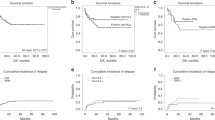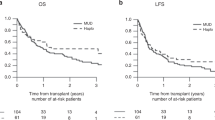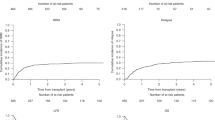Abstract
Patients transplanted with marrow from an HLA-ABDR serologically matched unrelated donor suffer from more post-transplant complications than those who are transplanted with marrow from an HLA-identical sibling. This is most likely due to either HLA-ABDR incompatibilities not resolved by standard techniques and/or HLA polymorphisms not tested for by routine tissue typing (HLA-Cw,-DQ). By resolving these incompatibilities by molecular techniques combined with the in vitro cytotoxic T lymphocyte precursor frequency (CTLpf) test, we have shown that a high degree of HLA compatibility is associated with increased patient survival. However, higher requirements for HLA matching decrease the number of available donors. We have estimated the probability of finding an HLA-A/B/Cw/DRB1/DRB3/DRB5/DQB1 compatible donor based on 104 consecutive unrelated bone marrow donor searches initiated between January 1995 and December 1997, with December 1998 as the endpoint. For 96 patients (92.3%), one or more ABDR-identical donors were listed in the Bone Marrow Donor Worldwide Registry (BMDW). After contacting the registries, we obtained at least one (mean, 5.36; range, 1–20; total, 461) blood sample for 86 patients. A highly compatible donor was identified for 33/86 patients (38.4%), after testing an average number of 4.5 donors/patients (range, 1–13). However, by accepting an HLA-DRB3 or -DQB1 or -Cw incompatibility, this number would be as high as 68.6%. Approximately half of the patients (n = 40) for whom a search had been initiated have been transplanted: 22 patients with a perfectly matched donor, 15 patients with an HLA-DRB3 or -DQB1 or -Cw mismatch and three with other mismatches. The average time needed to identify the most compatible donor was 4 months. Extremely long searches seemed to be less useful, because after testing the first seven, a more compatible donor was seldom found. These results show that even when requirements for compatibility are high, the chances of finding a donor remain considerable. Bone Marrow Transplantation (2000) 26, 437–441.
This is a preview of subscription content, access via your institution
Access options
Subscribe to this journal
Receive 12 print issues and online access
$259.00 per year
only $21.58 per issue
Buy this article
- Purchase on Springer Link
- Instant access to full article PDF
Prices may be subject to local taxes which are calculated during checkout

Similar content being viewed by others
References
Anasetti C, Etzioni R, Petersdorf EW et al. Marrow transplantation from unrelated volunteer donors Ann Rev Med 1995 46: 169–179
Hansen JA, Petersdorf E, Martin PJ, Anasetti C . Hematopoietic stem cell transplants from unrelated donors Immunol Rev 1997 157: 141–151
Gratwohl A, Passweg J, Baldomero H, Hermans J . Blood and marrow transplantation activity in Europe 1997 Bone Marrow Transplant 1999 24: 231–244
Oudshoorn M, Cornelissen JJ, Fibbe WE et al. Problems and possible solutions in finding an unrelated bone marrow donor. Results of consecutive searches for 240 Dutch patients Bone Marrow Transplant 1997 20: 1011–1017
Tiercy J-M, Morel C, Freidel AC et al. Selection of unrelated donors for bone marrow transplantation is improved by HLA class II genotyping with oligonucleotide hybridization Proc Natl Acad Sci USA 1991 88: 7121–7125
Rufer N, Tiercy J-M, Breur-Vriesendorp B et al. Histoincompatibilities in ABDR-matched unrelated donor recipient combinations Bone Marrow Transplant 1995 16: 641–646
Petersdorf EW, Longton GM, Anasetti C et al. The significance of HLA-DRB1 matching on clinical outcome after HLA-A,B,DR identical unrelated donor marrow transplantation Blood 1995 86: 1606–1613
Grundschober C, Rufer N, Sanchez-Mazas A et al. Molecular characterization of HLA-C incompatibilities in HLA-ABDR matched unrelated bone marrow donor/recipient pairs. Sequence of two new Cw alleles (Cw*02023 and Cw*0707) and recognition by cytotoxic T lymphocytes Tissue Antigen 1997 49: 612–623
Santamaria P, Reinsmoen N, Lindstrom A et al. Frequent HLA class I and DP sequence mismatches in serologically (HLA-A, HLA-B, HLA-DR) and molecular (HLA-DRB1, HLA-DQA1, HLA-DQB1) HLA identical unrelated bone marrow transplant pairs Blood 1994 83: 280–287
Charron DJ . HLA matching in unrelated bone marrow donor Curr Opin Hematol 1996 3: 416–422
Madrigal JA, Scott I, Arguello R et al. Factors influencing the outcome of bone marrow transplants using unrelated donors Immunol Rev 1997 157: 153–166
Petersdorf E, Longton GM, Anasetti C et al. Association of HLA-C disparity with graft failure after marrow transplantation from unrelated donors Blood 1997 89: 1818–1823
Ottinger HD, Albert E, Arnold R et al. German consensus on immunogenetic donor search for transplantation of allogeneic bone marrow and peripheral blood stem cells Bone Marrow Transplant 1997 20: 101–105
Hurley CK, Wade JA, Oudshoorn M et al. Histocompatibility testing guidelines for hematopoietic stem cell transplantation using volunteer donors: report from the World Marrow Donor Association Bone Marrow Transplant 1999 24: 119–121
Speiser DE, Tiercy J-M, Rufer N et al. High resolution matching associated with decreased mortality after unrelated bone marrow transplantation Blood 1996 87: 4455–4462
Sasazuki T, Juji T, Morishima Y et al. Effect of matching of class I HLA alleles on clinical outcome after transplantation of hemotopoietic stem cells from an unrelated donor New Engl J Med 1998 339: 1177–1185
Tron de Bouchony E, Leberre C, Dauriac C et al. Relevance of 10 Caucasian HLA haplotypes in searches for unrelated bone marrow donors for 100 patients from a single center Bone Marrow Transplant 1995 15: 845–851
Speiser DE, Tiercy J-M, Rufer N et al. Relation between the resolution of HLA-typing and the chance of finding an unrelated bone marrow donor Bone Marrow Transplant 1994 13: 805–809
Ottinger H, Grosse-Wilse M, Schmitz A, Grosse-Wilde H . Immunogenetic marrow donor search for 1012 patients: a retrospective analysis of strategies, outcome and costs Bone Marrow Transplant 14: (Suppl.4) S34–S38
Tiercy J-M, Roosnek E, Speiser D et al. Replacement of HLA class II serology by the HLA-DR microtitre plate oligotyping assay: a one year experience in unrelated bone marrow donor selection Br J Haematol 1993 85: 417–418
Naruse TK, Ando R, Nose Y et al. HLA-DRB4 genotyping by PCR-RFLP: diversity in the association between HLA-DRB4 and DRB1 alleles Tissue Antigen 1997 49: 152–159
Tiercy J-M, Djavad N, Rufer N et al. Oligotyping of HLA-A2, A3, and B44 subtype: detection of subtypes-incompatibilities between patients and their serologically matched unrelated bone marrow donors Hum Immunol 1994 41: 207–215
Gauchat-Feiss D, Rufer D, Speiser D et al. Heterogeneity of HLA-B35: oligotyping and direct sequencing for B35 subtypes reveals a high mismatching rate in B35 serologically compatible kidney and bone marrow donor/recipient pairs Transplantation 1995 60: 869–873
Roosnek E, Tiercy J-M . The search for an unrelated HLA-compatible stem cell donor Curr Opin Hematol 1999 6: 365–370
Petersdorf EW, Smith AG, Mickelson EM et al. The role of HLA-DPB1 disparity in the development of acute graft-versus-host disease following unrelated donor marrow transplantation Blood 1993 81: 1923–1932
Bodmer JG, Marsh SGE, Albert ED et al. Nomenclature for factors of the HLA system 1998 Tissue Antigen 1999 53: 407–446
Beatty PG, Dahlberg S, Mickelson EM et al. Probability of finding HLA-matched unrelated marrow donors Transplantation 1988 45: 714–718
Kernan NA, Bartsch G, Ash RC et al. Analysis of 462 transplantations from unrelated donors facilitated by the National Marrow Donor program New Engl J Med 1993 328: 593–602
Acknowledgements
We would like to acknowledge the collaboration of Mrs G Baillif and Mrs I Wenger from the Swiss Bone Marrow Donor Registry. We also thank the technical staff of the LNRH for tissue typing. This work was supported by the Swiss National Science Foundation (grant 31–45899.95 and 31–53774.98) and by the Dr Henri Dubois-Ferrière-Dinu Lipatti Foundation.
Author information
Authors and Affiliations
Rights and permissions
About this article
Cite this article
Tiercy, JM., Bujan-Lose, M., Chapuis, B. et al. Bone marrow transplantation with unrelated donors: what is the probability of identifying an HLA-A/B/Cw/DRB1/B3/B5/DQB1-matched donor?. Bone Marrow Transplant 26, 437–441 (2000). https://doi.org/10.1038/sj.bmt.1702529
Received:
Accepted:
Published:
Issue Date:
DOI: https://doi.org/10.1038/sj.bmt.1702529
Keywords
This article is cited by
-
Tandem autologous-allo-SCT is feasible in patients with high-risk relapsed non-Hodgkin’s lymphoma
Bone Marrow Transplantation (2013)
-
The impact of frequent HLA haplotypes in high linkage disequilibrium on donor search and clinical outcome after unrelated haematopoietic SCT
Bone Marrow Transplantation (2013)
-
What are a patient's current chances of finding a matched unrelated donor? Twenty years’ central search experience in a small country
Bone Marrow Transplantation (2012)
-
Hematopoietic SCT from partially HLA-mismatched (HLA-haploidentical) related donors
Bone Marrow Transplantation (2008)
-
Matched unrelated bone marrow transplant for T+ combined immunodeficiency
Bone Marrow Transplantation (2008)



